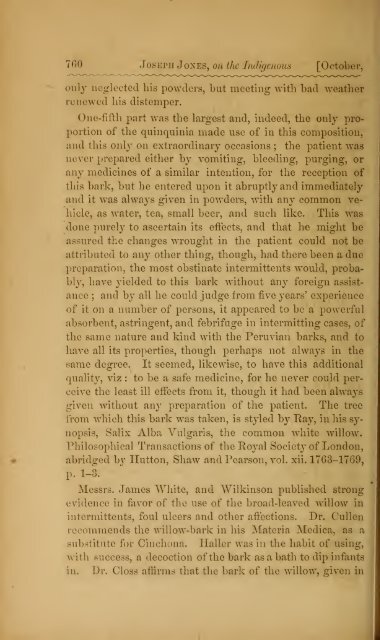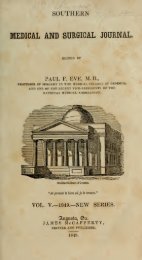Issue 10, pp. 753-832, October 1861, SMSJ
Issue 10, pp. 753-832, October 1861, SMSJ
Issue 10, pp. 753-832, October 1861, SMSJ
Create successful ePaper yourself
Turn your PDF publications into a flip-book with our unique Google optimized e-Paper software.
760 Joseph Jones, on the Indigenous [<strong>October</strong>,only neglected his powders, but meeting with bad weatherrenewed his distemper.One-fifth part was the largest and, indeed, the only proportionof the quinquinia made use of in this composition,and this only on extraordinary occasions ; the patient wasnever prepared cither by vomiting, bleeding, purging, orany medicines of a similar intention, for the reception ofthis bark, but he entered upon it abruptly and immediatelyand it was always given in powders, with any common vehicle,as water, tea, small beer, and such like. This wasdone purely to ascertain its effects, and that he might beassured the changes wrought in the patient could not beattributed to any other thing, though, had there been a duepreparation, the most obstinate intermittents would, probably,have yielded to this bark without any foreign assistance;and by all he could judge from five years' experienceof it on a number of persons, it a<strong>pp</strong>eared to be a powerfulabsorbent, astringent, and febrifuge in intermitting cases, ofthe same nature and kind with the Peruvian barks, and tohave all its properties, though perhaps not always in thesame degree. It seemed, likewise, to have this additionalquality, viz :to be a safe medicine, for he never could perceivethe least ill effects from it, though it had been alwaysgiven without any preparation of the patient. The treefrom which this bark was taken, is styled by Ray, in his synopsis,Salix Alba Vulgaris, the common white willow.Philosophical Transactions of the Royal Society of London,abridged bv Ilutton, Shaw and Pearson, vol. xii. 1763-1769,p. 1-3.Messrs. James White, and Wilkinson published strongevidence in favor of the use of the broad-leaved willow inintermittents, foul ulcers and other affections. Dr. Cullenrecommends the willow-bark in his Materia Medica, as asubstitute for Cinchona. I taller was in the habit of using,with success, a decoction of the bark as a bath to dip infantsin.Dr. Closs affirms that the bark of the willow, given in








